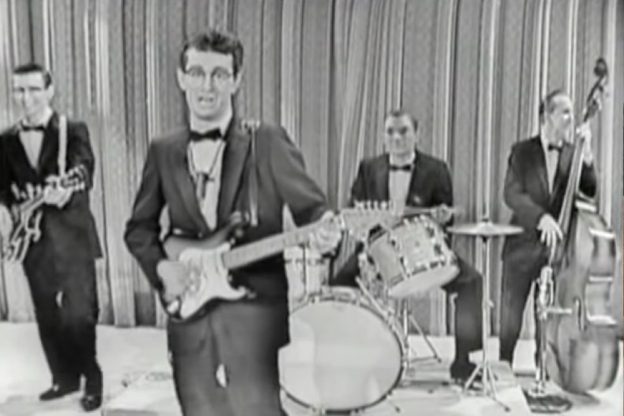On Feb. 3, 1959, one of the biggest tragedies in rock ‘n’ roll history took place. On that tragic day, a plane crashed on a frozen Iowa cornfield, with three of the greatest rockstars of that time among its passengers: Buddy Holly, Ritchie Valens and The Big Bopper.
Estimated reading time: 4 minutes
In this article on the Day the Music Died you’ll find
Now, 64 years later, it’s hard to imagine the impact of such a horrible tragedy. Just picture this: one day you wake up, check your phone and a big pop-up tells you Drake, Justin Bieber, The Weeknd, Adele and Taylor Swift died in the same plane crash. That would be really messed up, right?
The Day the Music Died Channel
So yeah, the third of February 1959 was a pretty messed up day for music lovers. But it’s also a day we have to remember. We want to honor these bright stars of rock ‘n’ roll with a special channel: The Day the Music Died. Where you can play along with some of their greatest hits.
Maybe you already know some of them, maybe you don’t. Either way, it’s fun to try out new stuff and it’s great to remember that there are so many awesome tracks written back in the day when rock ‘n’ roll was just an up-and-coming genre.
Buddy Holly
In case you don’t know or have forgotten, let’s jog your memory by asking: Who were Buddy Holly, Ritchie Valens and The Big Bopper? Starting with the first of these legends. Buddy Holly (22 years old when the plane crashed) started off as a country singer. But, after seeing The King live in 1955, Holly soon realized rock ‘n’ roll was the way to go.
Upon hitting the charts with the track “That’ll Be the Day“, Holly teamed up with drummer Jerry Allison and bass player Joe Mauldin. Together they formed a band and named themselves The Crickets. The young and talented Holly recorded two hit songs with them: “Peggy Sue“ and “Oh Boy!.”
Mauldin and Allison couldn’t handle the extensive and exhausting life of being on tour, so the band broke up in 1958. In the winter of 1959 Buddy Holly decided to do another U.S. tour: “Winter Dance Party.” This time, he teamed up with musicians Waylon Jennings, Tommy Allsup and Carl Bunch.
The Big Bopper
Even though Buddy Holly was the headliner of the “Winter Dance Party,” he was touring with other performers. One of them was J.P. Richardson, known as the The Big Bopper – he was 28 years old when the plane crashed on the third of February.
The Big Bopper was best known for his disk jockey career. In this capacity he established the world record for continuous broadcasting: 1,821 tracks for five days, two hours and eight minutes. During this attempt, Richardson lost sixteen kilograms. Now that’s what we call a true showbiz warrior.
After a successful career playing other people’s songs, Richardson started writing his own. He recorded the number one hit “Chantilly Lace“ and other famous tracks like “White Lightning” and “Running Bear.”
During the “Winter Dance Party” tour, The Big Bopper caught a nasty cold. So, when Buddy Holly decided to charter a plane for his band, Richardson asked Waylon Jennings if he could trade places with him. Jennings said yes.
Ritchie Valens
The youngest of the gang was 17-year-old Ricardo Esteban Valenzuela Reyes, who was gaining popularity by the day. The rock ‘n’ roller of Mexican descent was the founder of the style that would later be called “Chicano rock.” His manager suggested the name Ritchie Valens, keeping his latino roots hidden from the public so they wouldn’t judge Ricardo before listening to his records.
When the young Ritchie got his first record deal, he recorded two songs which made him instantly popular with the teens: “Donna” and “Come On, Let’s Go.” But the track that made him immortal was actually the B-side of “Donna”: a rock ‘n’ roll version of a Mexican folk song called “La Bamba.”
The tour bus on “Winter Dance Party” was old, uncomfortable and unbearably cold. Artists caught the flu and even frostbite. Ritchie didn’t want to end up with a fever like The Big Bopper, so he asked Buddy Holly’s bandmate Tommy Allsup if he could trade places with him on the plane flying from Clear Lake, Iowa to Fargo, North Dakota. Allsup was against it but Valens kept asking, so they tossed a coin. Ritchie won. To add some tragic irony, Valens used to have a fear of flying, but overcame it because he really wanted a career in music.
The Day the Music Died
Nobody knows what really happened on that tragic night, but the small, single-engine airplane crashed right after take-off. It’s most likely that the sudden, aggressive snow storm above Clear Lake, Iowa had something to do with the crash .
Years later, Don McLean wrote the song “American Pie,” a tribute to the rock ‘n’ roll heroes who lost their lives. He called it “The Day the Music Died.”


